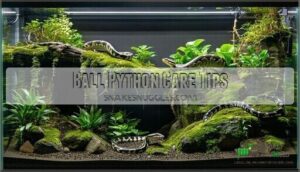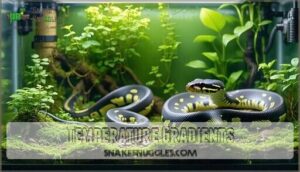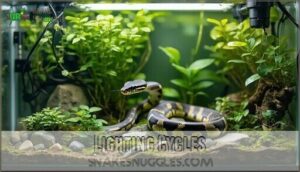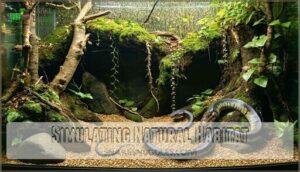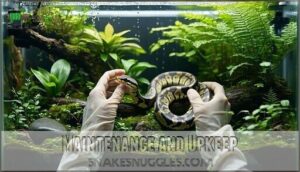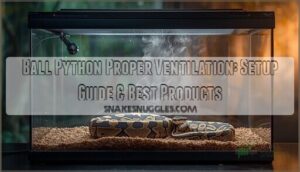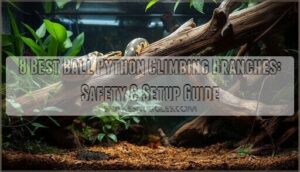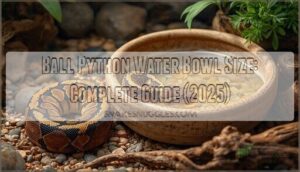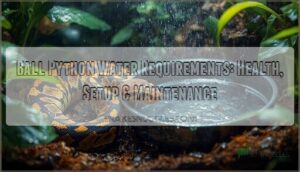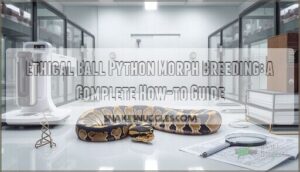This site is supported by our readers. We may earn a commission, at no cost to you, if you purchase through links.
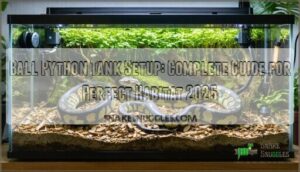
You’ll need precise temperature gradients—78-80°F cool side, 88-92°F warm side—using under-tank heaters with thermostats.
Maintain 50-60% humidity through water bowls and substrate moisture. Provide identical hiding spots on both temperature zones, plus safe substrate like cypress mulch or aspen shavings.
Don’t forget secure lids and proper ventilation. Getting these fundamentals right prevents feeding strikes and stress-related issues that plague many ball python owners.
Table Of Contents
- Key Takeaways
- Ball Python Habitat
- Tank Setup Essentials
- Ball Python Care Tips
- Creating Natural Environment
- Maintenance and Upkeep
- Frequently Asked Questions (FAQs)
- Is a 40 gallon tank too big for a baby ball python?
- What is the best enclosure setup for a ball python?
- What quarantine period is needed for new ball pythons?
- How often should ball python tanks be completely cleaned?
- Can multiple ball pythons share the same enclosure safely?
- What signs indicate a ball python is stressed or sick?
- How do you safely transport a ball python?
- Conclusion
Key Takeaways
- You’ll need a 40-gallon minimum tank for juveniles, upgrading to 75-120 gallons for adults – proper sizing prevents stress and allows natural behaviors throughout your snake’s growth stages.
- Maintain precise temperature gradients with 78-80°F on the cool side and 88-92°F on the warm side – use under-tank heaters with thermostats to create thermal zones that let your python thermoregulate naturally.
- Keep humidity between 50-60% using water bowls and substrate moisture – proper humidity prevents respiratory issues and supports healthy shedding cycles.
- Provide secure hiding spots on both temperature zones plus safe substrate – identical hides on warm and cool sides with cypress mulch or aspen shavings create security and prevent feeding strikes.
Ball Python Habitat
Creating the perfect ball python habitat starts with understanding their specific environmental needs and natural behaviors.
You’ll need to carefully balance temperature, humidity, and space requirements to guarantee your snake thrives in captivity, which involves a deep understanding of their natural behaviors.
Tank Size Requirements
Tank dimensions substantially impact your ball python’s health and behavior. Hatchlings need 10-gallon tanks, juveniles require 20-30 gallons, while adults thrive in 40-75 gallon enclosures with proper space requirements.
Right-sized homes keep ball pythons healthy and stress-free throughout their lives.
As they grow, regular tank upgrades are vital for their well-being.
Key habitat volume guidelines:
- Hatchlings (under 300g): 20″ x 11″ x 13″ minimum for animal comfort
- Juveniles (under 3 feet): 36″ x 18″ x 18″ with adequate enclosure depth
- Adults (over 3 feet): 48″ x 24″ x 24″ for ideal python tank size
Enclosure Materials
Three essential materials dominate ball python enclosure construction: glass, PVC, and melamine. Each material affects heat retention, material safety, and cost analysis differently.
Glass offers excellent visibility but requires careful handling due to enclosure weight. PVC provides superior insulation for your ball python habitat while maintaining aesthetic appeal for snake tank decor.
| Material | Heat Retention | Cost Analysis |
|---|---|---|
| Glass | Poor insulation, heat loss | Low initial cost, higher heating bills |
| PVC | Excellent insulation, stable temps | Medium cost, energy efficient |
| Melamine | Good insulation, moisture resistant | Higher upfront, durable investment |
Glass terrariums work well for python tank size requirements but struggle with temperature stability. PVC enclosures excel in reptile tank setup scenarios, offering lightweight construction and superior heat retention.
For ball python enclosure ideas, melamine provides professional-grade durability with customizable aesthetic appeal. When designing a ball python habitat, considering PVC snake options is vital for effective temperature control and safety.
Ventilation Systems
After choosing your enclosure materials, proper air flow becomes your next priority. Ball pythons need adequate ventilation to prevent respiratory issues and maintain healthy air quality.
You’ll want mesh screens covering 10-15% of your tank’s surface area.
Here’s what you need for ideal ventilation:
- Vent pipes positioned at opposite ends create cross-ventilation that prevents stagnant air pockets
- Fan systems with adjustable speeds help circulate air without creating drafts that stress your snake
- Exhaust vents remove humid air while maintaining proper humidity levels for your ball python habitat
Quality ventilation prevents mold growth and respiratory infections while supporting your reptile tank maintenance routine. Properly installed vent pipe systems are essential for a healthy ball python environment.
Heating and Lighting
Proper thermal management creates the foundation for your ball python’s health and happiness. You’ll need overhead heating like halogen bulbs or deep heat projectors for effective basking spots, while ceramic heat emitters handle nighttime warmth without disrupting sleep cycles.
Understanding the UVB lighting needs is essential for simulating a natural environment.
| Heat Zone | Temperature Range | Lighting Type | Duration |
|---|---|---|---|
| Basking Spot | 90-95°F (32-35°C) | Halogen/DHP | 12 hours |
| Warm Hide | 86-90°F (30-32°C) | Heat mat/CHE | 24 hours |
| Cool Hide | 72-80°F (22-27°C) | Ambient only | 24 hours |
| Night Drop | 70-78°F (21-25°C) | CHE/RHP only | 12 hours |
Install quality thermostats with all heat sources—your snake’s life depends on temperature control. UVB lighting isn’t essential but supports natural behaviors and vitamin D3 synthesis.
Use T5 HO fluorescent tubes rather than coil bulbs for ideal UVB provision.
Tank Setup Essentials
Your python’s home starts with selecting the right tank materials.
Glass terrariums offer superior visibility and heat retention compared to plastic alternatives.
You’ll need proper water quality management through filtration systems that maintain clean conditions without creating excessive water movement that stresses your snake.
Consider substrate depth carefully – two to three inches of cypress mulch or aspen shavings allows natural burrowing behaviors while preventing impaction risks.
Your filtration systems should include both mechanical and biological components to handle waste effectively.
Tank decor serves dual purposes: enrichment and functionality.
Sturdy branches, artificial plants, and textured backgrounds create visual barriers that reduce stress.
When planning your python enclosure ideas, remember that ball python care requires security above aesthetics.
Temperature regulation depends on your chosen heating elements working harmoniously with your substrate choice.
Snake tank temperature zones need consistent monitoring equipment placed at substrate level where your python actually experiences the heat.
Python tank decoration should prioritize your snake’s psychological comfort through strategic placement of hiding spots and climbing opportunities.
Understanding proper ventilation is vital for maintaining a healthy environment for your pet.
This includes ensuring your python has adequate space and visual barriers to reduce stress, and that the tank is well-ventilated to prevent the buildup of harmful gases.
Ball Python Care Tips
You’ve properly set up your ball python’s habitat, but the real magic happens when you master the daily care requirements that keep your snake thriving.
These essential care tips will transform your enclosure from a simple container into a perfectly balanced microenvironment that supports your python’s natural behaviors and health.
Humidity Control
Maintaining python humidity levels between 50-60% keeps your ball python healthy and comfortable.
Position large water bowls on the warm side to boost evaporation naturally. Install humidifier systems or fogging machines for consistent moisture control.
Use hygrometer calibration to monitor levels accurately.
During shedding, increase humidity to 70-80% through spray misting or humid hides with damp moss.
Substrate Options
Several substrate options work well for ball python tanks.
Reptile Carpet provides easy cleaning and prevents impaction risks.
Coconut Fiber retains humidity naturally while allowing natural digging behaviors.
Sphagnum Moss excels at maintaining moisture levels but requires frequent replacement.
Avoid Sand Substrate completely – it causes dangerous impaction when ingested.
Wood Shavings work if cedar-free, though they’re less ideal for humidity control than other ball python substrate choices.
For ideal reptile care, consider using reptile carpet products to create a safe and healthy environment.
Water and Hydration
Your ball python needs fresh water available 24/7. Use a heavy ceramic bowl that won’t tip over – python water bowl size should allow coiling but prevent drowning.
Replace water weekly or when soiled. Quality water means dechlorinated tap water or bottled spring water.
Clean drinking bowls prevent bacteria buildup. Monitor humidity levels, as water evaporation affects overall tank moisture.
Proper ball python care is essential for maintaining a healthy environment.
Hiding Places and Decor
Two strategic snake hiding places create security for your ball python.
Install one hide box on the warm side and another on the cool side, ensuring both fit your snake snugly.
Rock caves and log hides work excellently, while plant decor adds natural appeal.
Choose reptile tank accessories that won’t interfere with ball python lighting or complicate snake tank cleaning routines.
Creating Natural Environment
You’ll want to replicate your ball python’s West African savanna origins through careful environmental design.
Creating temperature gradients, proper lighting cycles, and naturalistic décor transforms a basic enclosure into a thriving microhabitat that supports your snake’s physiological and behavioral needs.
This setup allows for a thriving microhabitat that meets the needs of your ball python.
Temperature Gradients
Temperature gradients create thermal zones that let your ball python thermoregulate naturally.
Position heat sources on one side to establish a basking spot at 90-95°F, while the cool side stays at 75-80°F.
This gradient control prevents temperature fluctuations that stress snakes, and use heat mapping techniques to verify your thermal zones work properly throughout the enclosure.
Lighting Cycles
Unlike their wild counterparts, ball pythons don’t require UVB lighting for vitamin D synthesis.
However, establishing consistent day night cycles helps regulate their natural photoperiod.
You’ll want to maintain 12-hour light intensity periods followed by darkness.
This cycle duration mimics their native African environment, supporting healthy feeding patterns and overall well-being in your reptile tank setup, which is crucial for their natural development.
Simulating Natural Habitat
Your ball python’s enclosure transforms into a thriving ecosystem when you replicate their West African grassland origins.
Transform your tank into West Africa’s savanna—your python will thrive in authentic grassland conditions.
Create terrain features using cork bark, driftwood, and artificial rock formations to mimic natural landscape variations. Environmental factors like substrate depth and hide placement directly influence ecosystem balance and behavioral expression.
- Habitat Design: Layer coconut fiber substrate 4-6 inches deep with scattered leaf litter for authentic ground cover
- Natural Lighting: Implement 12-hour day/night cycles using LED panels to regulate circadian rhythms
- Terrain Features: Add climbing branches at various heights and angles for exercise and thermoregulation
- Reptile Tank Security: Install secure latches and escape-proof mesh tops while maintaining proper ventilation flow
Plant and Decoration Selection
Creating the perfect habitat extends beyond temperature control to thoughtful plant and decoration selection. Your choices directly impact your snake’s stress levels and overall well-being.
Live plants offer natural humidity regulation and aesthetic appeal, but require proper reptile tank heating and ball python lighting to thrive. Artificial alternatives eliminate maintenance concerns while providing similar visual benefits.
| Decoration Type | Best Options |
|---|---|
| Live Plants | Pothos, snake plants, bromeliads |
| Decor Themes | Natural wood, desert rock formations |
| Water Features | Shallow ceramic bowls, drip systems |
| Rock Selection | Slate, sandstone, smooth river rocks |
| Background Designs | 3D foam, natural bark panels |
Consider reptile tank security when selecting decorations. Avoid sharp edges or unstable items that could injure your python. Heavy decorations should be secured to prevent accidents during feeding sessions or tank cleaning routines. To create a thriving environment, understanding bioactive substrate mix is essential for maintaining ideal humidity and temperature levels.
Maintenance and Upkeep
Once you’ve created the perfect ball python habitat, maintaining it becomes your ongoing responsibility to guarantee your snake’s health and happiness.
Regular maintenance tasks include weekly cleaning routines, daily monitoring of environmental conditions, establishing proper feeding schedules, and learning safe handling techniques that build trust between you and your serpent companion.
The tasks are interconnected, with weekly cleaning routines and daily monitoring of environmental conditions being crucial for maintaining a healthy environment.
Cleaning and Disinfection
Your ball python’s tank needs regular cleaning to prevent bacterial growth and maintain healthy conditions.
Spot-clean waste immediately using reptile-safe disinfectant types like diluted bleach solution or commercial reptile cleaners.
Deep-clean monthly by removing all substrate, washing water bowls, and sanitizing surfaces.
These hygiene practices prevent odors and disease while keeping your snake’s environment pristine, and following these regular cleaning schedules is crucial for maintaining a healthy environment, which includes reptile-safe disinfectant types.
Monitoring Temperature and Humidity
Maintaining proper Climate Monitoring guarantees your ball python’s health and prevents costly veterinary visits.
Digital thermometer-hygrometer combos provide accurate Temperature Control readings, while infrared guns measure Heat Sources precisely.
Place probes at snake level for reliable data.
Monitor Humidity Levels between 50-60% normally, raising to 70-80% during shedding.
Effective Moisture Management prevents respiratory infections and supports healthy shedding cycles.
Feeding and Nutrition
How often should you feed your ball python? The answer depends on age and size, making proper scheduling vital for health.
Food Options and Feeding Schedule considerations:
- Meal Size: Feed prey equal to 10-15% of your snake’s body weight
- Dietary Needs: Hatchlings eat every 5-7 days, adults every 2-3 weeks
- Nutrient Balance: Whole frozen-thawed rodents provide complete nutrition
Adult ball pythons naturally eat only 10 meals yearly, so resist overfeeding. Monitor your snake’s weight regularly during ball python feeding to confirm proper growth without obesity.
Handling and Socialization
Your bond with your ball python deepens through consistent, gentle handling sessions. Start with brief five-minute interactions, allowing your snake to recognize your scent and touch.
Use slow movements and support their body weight fully. Trust building happens gradually—rushing leads to defensive behavior.
Always handle after digestion completes, typically 48-72 hours post-feeding. Clean hands prevent transferring oils or residues that might stress your python, and gentle handling is crucial for trust building to occur, which happens over time with consistent interactions.
Frequently Asked Questions (FAQs)
Is a 40 gallon tank too big for a baby ball python?
A 40-gallon tank isn’t too big for a baby ball python, but you’ll need plenty of hiding spots and clutter.
Young snakes feel secure in smaller spaces, so create cozy zones within that larger environment for maximum comfort.
What is the best enclosure setup for a ball python?
Like a fortress protecting precious treasure, your ball python’s enclosure becomes their sanctuary.
You’ll need secure hiding spots on both warm and cool sides, proper substrate for burrowing, reliable heating elements, and adequate ventilation for peak health.
What quarantine period is needed for new ball pythons?
You’ll need to quarantine your new ball python for 30-60 days in a separate enclosure.
This prevents spreading diseases to other reptiles and allows you to monitor eating, shedding, and overall health.
How often should ball python tanks be completely cleaned?
Research shows 80% of reptile health issues stem from poor husbandry practices. You’ll want to deep-clean your ball python’s enclosure monthly, spot-cleaning waste immediately and changing water weekly for ideal health.
Can multiple ball pythons share the same enclosure safely?
Ball pythons shouldn’t cohabitate – they’re solitary creatures that’ll compete for resources, experience stress, and potentially transmit diseases. You’ll also struggle identifying which snake has health issues during monitoring.
What signs indicate a ball python is stressed or sick?
Canaries in coal mines once warned of danger—your ball python shows stress through defensive posturing, excessive hiding, refusal to eat, irregular shedding, respiratory infections, or lethargy.
Requiring immediate veterinary attention is crucial in such cases, as these signs can indicate serious health issues.
How do you safely transport a ball python?
Use a secure, ventilated transport container with proper substrate.
Maintain appropriate temperature during travel with heating pads if needed.
Minimize handling and movement.
Keep the journey short and monitor stress signs throughout transport.
Conclusion
Successfully establishing your ball python tank setup requires attention to detail, patience with adjustments, and commitment to consistent monitoring.
You’ve learned the fundamental requirements: proper sizing, temperature gradients, humidity control, and secure hiding spots.
Remember that creating the perfect habitat isn’t just about following guidelines—it’s about understanding your snake’s individual needs and behaviors.
Monitor temperatures daily, maintain humidity levels religiously, and adjust your setup based on your python’s responses.
With these proven techniques, you’ll create a thriving environment that keeps your ball python healthy and stress-free for years.
- https://reptifiles.com/ball-python-care-guide/ball-python-terrarium-size-lighting/
- https://www.reptilerescuecenter.org/caresheets/ballpython/
- https://www.zenhabitats.com/collections/ball-python-enclosures
- https://www.reddit.com/r/ballpython/comments/100xbxp/cage_setup_tips/
- https://reptilesupply.com/blogs/how-to-guides/how-to-set-up-a-ball-python-enclosure

